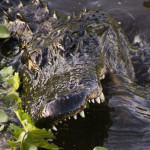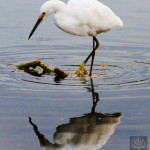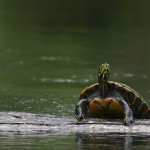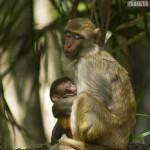Nature
-

-
An American alligator holds an intent stare over the surface of Lake Alice on the campus of the University of Florida during a recent Friday evening. Located in Gainesville, the university leaves the reptiles alone, regardless of their size—that is, unless they pose a danger and, under state wildlife, must be removed. “The policy of most alligators is to avoid humans,” UF wildlife researcher Frank Percival told me. “That is sometimes difficult, especially on a university campus.”
-

-
A rhesus monkey—also called a rhesus macaque—pulls plants out of the bank of Silver River outside Ocala, Fla., to eat their roots.
-

-
A male red-winged blackbird lets out a mating call at Paynes Prairie Reserve State Park in Micanopy, Fla., on a Tuesday evening. On nice days during mating season from February to August, the prairie is filled with calls from the male birds as they fly from perch to perch.
-

-

-

-
An American alligator chomps for fish at Paynes Prairie in Micanopy, Fla., on April 28. For the photographer, this was a birthday treat because the animals on the prairie are generally inactive during the day. The species is more than 150 million years old, according to National Geographic, and unlike the dinosaurs, it dodged extinction 65 million years ago.
-

-

-

-

-
A snowy egret searches for a meal in Lake Alice on the campus of the University of Florida during a Friday evening. The birds diet can include insects, small lizards, fish and other aquatic life, which it finds by stirring the bottom of shallow water with its feet. A common species, the snowy egret’s range covers immense sections of North, Central and South America, according to the International Union for Conservation of Nature and Natural Resources.
-

-

-
A rhesus monkey holds her child near the banks of Silver River outside Ocala, Fla. Natives to southern Asia, the monkeys were imported in 1938 and released onto a man-made island on the river by Colonel Tooey, says a 2010 article in Ocala Style Magazine. The boat captain was hoping to attract more visitors to his river tours, but the monkeys apparently weren’t satisfied with their new grounds. “The monkeys probably didn’t stay on the island 10 minutes” before swimming off and running into the woods, Bill Ray, who as a kid was there for the release, told the magazine.
-

-
Lori Gage, with the Florida Museum of Natural History’s Butterfly Rainforest, releases a golden birdwing (on hand) and several other butterfly species into the 6,400-square-foot, screened-in exhibit in Gainesville on April 28, 2013. Representing 60 to 80 butterfly and moth species, the exhibit’s insects live only six weeks or less and aren’t provided with the type of plants needed to reproduce. To keep it stocked with above 1,000, releases of specimens acquired from outside farms are scheduled daily.
-
















